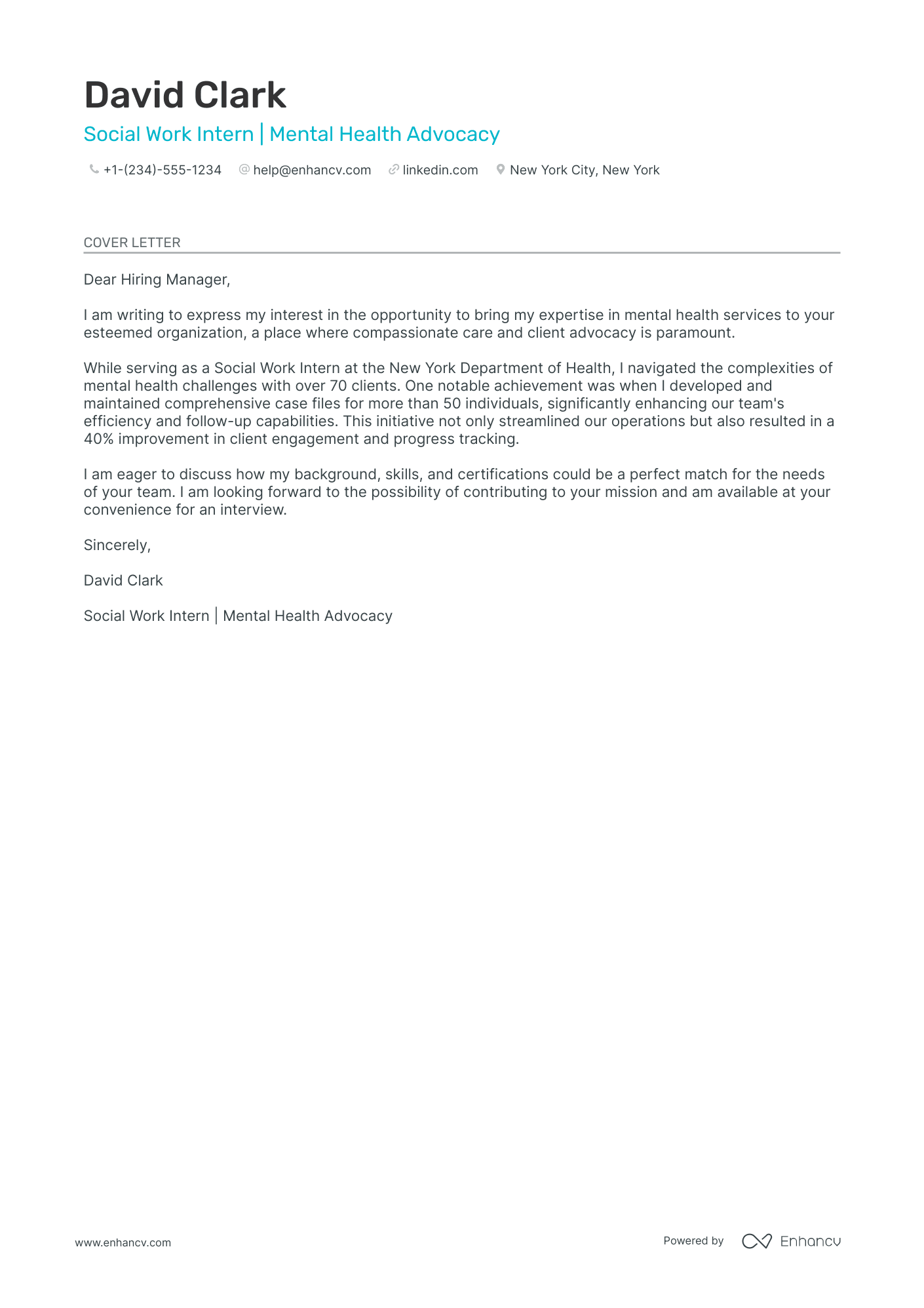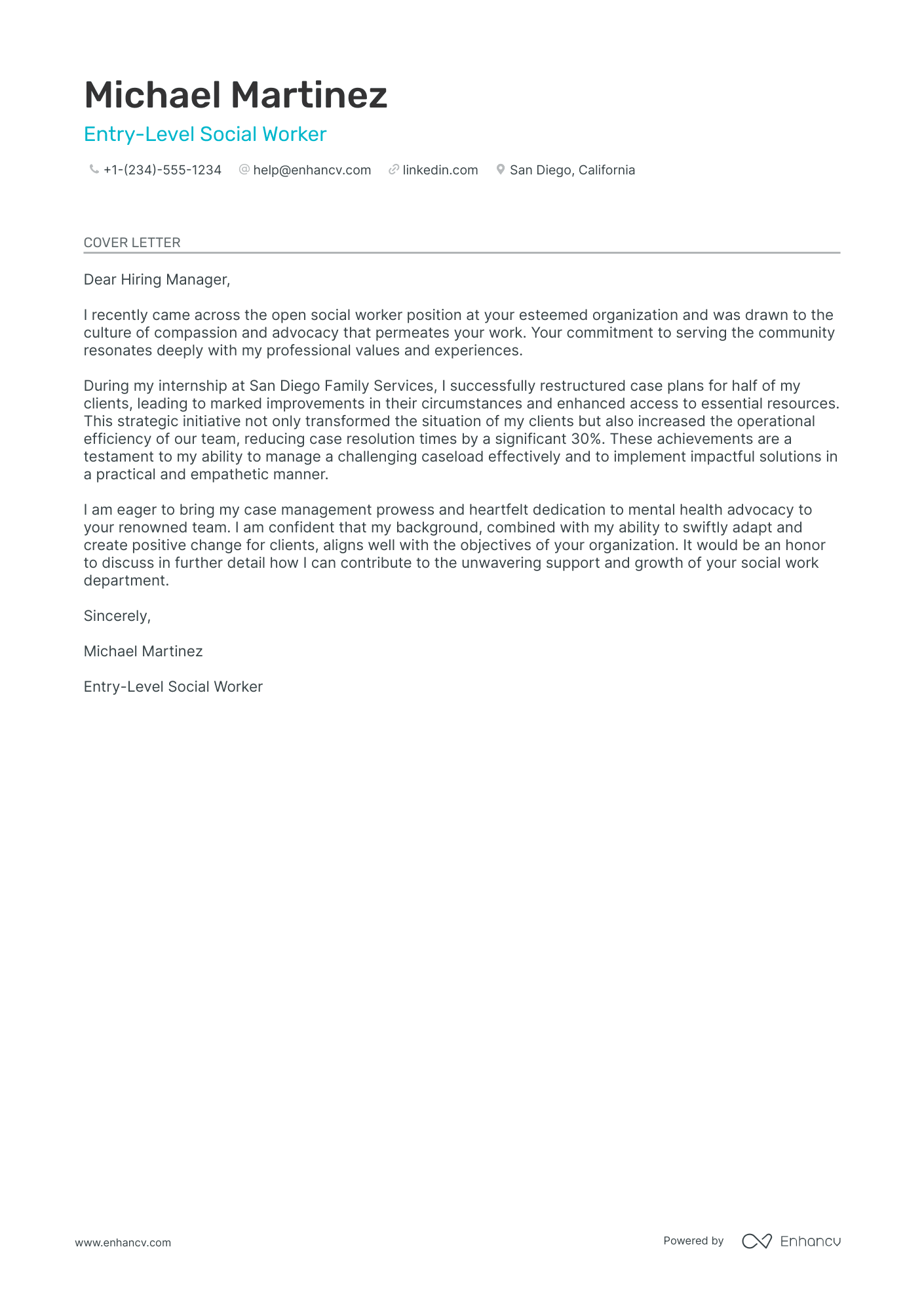Embarking on your job hunt, you’ve found that a compelling social worker cover letter is a must—but crafting one can be daunting. It's not just an echo of your resume; it must weave a narrative around your proudest professional triumph without wandering into clichés. Remember to keep it concise; a single page that combines formality with your personal story can open doors. Let’s walk through how to create a cover letter that stands out in a pile.
- Create a social worker cover letter to persuade the recruiters you're the best candidate for the role;
- Use industry-leading social worker cover letter templates and examples to save time;
- Dedicate your social worker cover letter space to your best achievement;
- Make sure your social worker cover letter meets recruiters' expectations and standards.
Avoid starting at the blank page for hours by using Enhancv's AI - just upload your resume and your social worker cover letter will be ready for you to (tweak and) submit for your dream job.
If the social worker isn't exactly the one you're looking for we have a plethora of cover letter examples for jobs like this one:
Drop your resume here or choose a file.
PDF & DOCX only. Max 2MB file size.
Social worker cover letter example
Andrew Clark
Kansas City, Missouri
+1-(234)-555-1234
help@enhancv.com
- Highlighting past achievements that align with the organization's mission (e.g., development and implementation of a client assessment protocol) showcases the applicant's initiative and relevant experience.
- Emphasizing quantifiable improvements (e.g., streamlining the intake process by 20%, managing a caseload effectively) provides a clear demonstration of the candidate's capability to bring positive changes to the organization.
- Mentioning specific skills (e.g., strategic problem-solving, empathetic communication style) identifies the candidate's strengths and suitability for the role.
- Expressing alignment with the organization's values and goals (e.g., commitment to enhancing community well-being) illustrates the candidate's cultural fit and motivation for the role.
What about your social worker cover letter format: organizing and structuring your information
Here is one secret you should know about your social worker cover letter assessment. The Applicant Tracker System (or ATS) won't analyze your cover letter.
You should thus focus on making an excellent impression on recruiters by writing consistent:
- Header
- Greeting
- Introduction
- Body paragraphs (and explanation)
- Promise or Call to action
- Signature (that's optional)
Now, let's talk about the design of your social worker cover letter.
Ensure all of your paragraphs are single-spaced and have a one-inch margins on all sides (like in our cover letter templates).
Also, our cover letter builder automatically takes care of the format and comes along with some of the most popular (and modern) fonts like Volkhov, Chivo, and Bitter.
Speaking of fonts, professionals advise you to keep your social worker cover letter and resume in the same typography and avoid the over-used Arial or Times New Roman.
When wondering whether you should submit your social worker cover letter in Doc or PDF, select the second, as PDF keeps all of your information and design consistent.
Why worry about your cover letter? Create one instantly using our free cover letter generator.
The top sections on a social worker cover letter
Header: Include your name, contact information, and the date, ensuring the recruiter knows who you are and how to reach you and establishing a professional look in your cover letter.
Salutation: Address the letter to the specific hiring manager or recruiter when possible, as personalized greetings are more engaging and show that you've done your homework about the agency or organization.
Introduction: Start with a brief introduction that not only states the job you're applying for, but also highlights your passion for social work and any relevant credential or experience that is specifically beneficial in this field.
Body Paragraph(s): Detail your relevant experience and key accomplishments in social work, including any specialized skills or successful interventions that would be of interest to the employer, showcasing your direct impact on client well-being and community improvement.
Closing Paragraph: Reiterate your enthusiasm for the position, thank the reader for their consideration, and express your desire to discuss your application further in an interview, leaving a confident and respectful last impression.
Key qualities recruiters search for in a candidate’s cover letter
- Empathy and Compassion: To understand and relate to the clients' emotional states and circumstances, fostering a trusting relationship.
- Crisis Intervention Skills: To effectively manage and navigate clients through emergencies and immediate social or mental health issues.
- Advocacy and Knowledge of Social Justice Issues: To champion clients' rights and provide informed support on issues such as poverty, discrimination, and access to services.
- Multicultural Competency: To effectively work with diverse populations and respect cultural differences in practice.
- Interpersonal and Communication Skills: To engage with clients, colleagues, and other professionals, facilitating dialogue and collaboration.
- Case Management Experience: To coordinate care effectively, linking clients with appropriate resources, and managing a caseload efficiently.
How to personalize your social worker cover letter greeting
Before you start writing your social worker cover letter, take the time to find out who is recruiting for the role.
Search for the recruiter's name on LinkedIn or the corporate website to address them personally in your social worker cover letter salutation.
What if you can't find out who's recruiting for the role?
Always aim to avoid the very impersonal "Dear Sir/Madam" - instead, opt out for "Dear HR Team" or "Dear Hiring Manager" to make a better first impression.
List of salutations you can use
- Dear Hiring Manager,
- Dear [Specific Name of the Hiring Manager],
- Dear [Department] Team,
- Dear [Company Name] Hiring Committee,
- Dear Human Resources Director,
- Dear [Job Title Search Committee],
How to start your social worker cover letter introduction
The opening paragraph of your social worker cover letter can seem like a real enigma.
Where do you start writing?
In your social worker cover letter introduction, focus on yourself by stating what:
- gets you motivated and excited about the role;
- you like best about the company, from culture to awards.
Write no more than two sentences, which are both authentic and show your enthusiasm for the opportunity.
Structuring your social worker cover letter body to add more value
You've hinted at your value as a professional (this may be your passion for the job or interest in the company) in your introduction.
Next, it's time to pan out the body or middle of your social worker cover letter.
When creating your resume, you've probably gone over the advert a million times to select the most relevant skills.
Well, it's time to repeat this activity. Or just copy and paste your previous list of job-crucial requirements.
Then, select one of your past accomplishments, which is relevant and would impress hiring managers.
Write between three and six paragraphs to focus on the value your professional achievement would bring to your potential, new organization.
Tell a story around your success that ultimately shows off your real value as a professional.
Closing paragraph basics: choose between a promise and a call to action
You've done all the hard work - congratulations! You've almost reached the end of your social worker cover letter.
But how do you ensure recruiters, who have read your application this far, remember you?
Most social worker professionals end their cover letter with a promise - hinting at their potential and what they plan on achieving if they're hired.
Another option would be to include a call for follow-up, where you remind recruiters that you're very interested in the opportunity (and look forward to hearing from them, soon).
Choose to close your social worker cover letter in the way that best fits your personality.
Keep this in mind when writing your zero experience social worker cover letter
Even though you may not have any professional experience, your social worker cover letter should focus on your value.
As a candidate for the particular role, what sort of skills do you bring about? Perhaps you're an apt leader and communicator, or have the ability to analyze situations from different perspectives.
Select one key achievement from your life, outside work, and narrate a story that sells your abilities in the best light.
If you really can't think of any relevant success, you could also paint the picture of how you see your professional future developing in the next five years, as part of the company.
Key takeaways
Your social worker cover letter is your best shot at standing out by showing your motivation and the unique skills you'd bring to the job:
- Chose no more than one achievement, which you'd be talking about in the body of your social worker cover letter, by focusing on skills and outcomes;
- Address recruiters with their first or last name, or "Dear Hiring Manager" in your social worker cover letter greeting;
- Introduce in no more than two sentences what makes your profile unique (perhaps it's your motivation, enthusiasm, or appreciation of the company you're applying for);
- Select the same font you have used in your resume (avoid Times New Roman and Arial, as most candidates tend to invest in them);
- Close your social worker cover letter with a promise of how you see yourself growing in the company and the benefits you'd bring about.
Social Worker cover letter examples
By Experience
Social Work Student
Social Work Intern
Entry-Level Social Worker
By Role
















